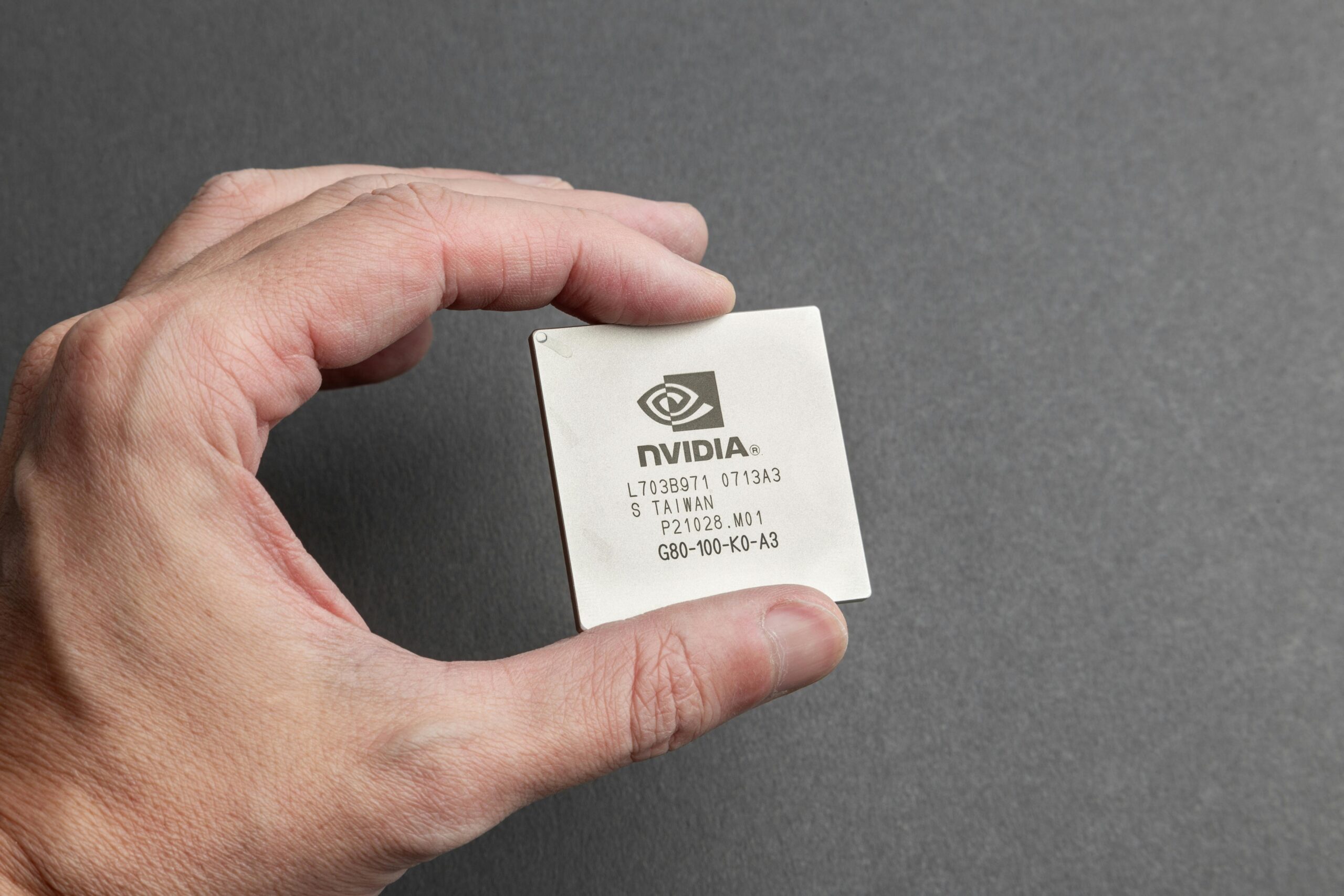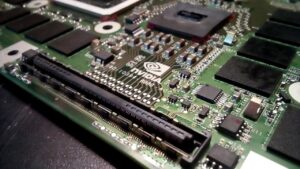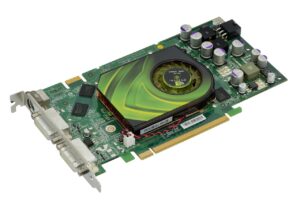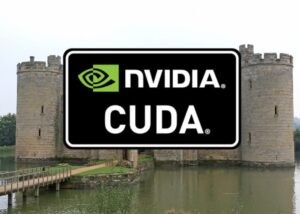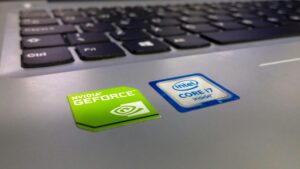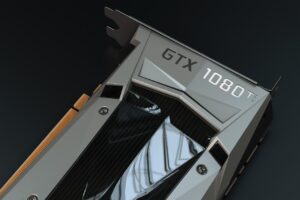Nvidia’s New Chip for China: What It Is, Why It Exists, and How It Could Reshape the AI Supply Chain
By Bits of Us — August 21, 2025
TL;DR
Nvidia is developing a new, China-compliant AI accelerator built on its latest Blackwell architecture that’s designed to outperform the H20—the Hopper-era chip Nvidia currently sells in China—but still remain within U.S. export limits. Reuters and SCMP reporting indicate the part is tentatively referred to as B30A, with a single-die design, HBM and NVLink, and performance targeted below Nvidia’s flagship Blackwell B300 so it can pass U.S. licensing. Samples could reach Chinese customers for testing as soon as the coming weeks, but ultimate approval is uncertain and Beijing’s stance has recently hardened around purchases of the existing H20. Reuters+1South China Morning Post
Context: How We Got Here
The “chip for China” idea is not new for Nvidia. Since 2022, successive U.S. rule updates have restricted the performance and interconnect characteristics of GPUs sold into China. Nvidia initially created downgraded variants (A800, then H800) to comply, and in late 2023–2024 it introduced H20, a Hopper-based accelerator engineered specifically for the Chinese market. That pathway has been bumpy:
-
In April 2025, the U.S. tightened controls again, effectively halting H20 exports and forcing Nvidia to book $5.5 billion in charges related to inventory and prior sales plans. Reuters
-
Nvidia then worked on a modified H20 to fit the new thresholds. By May 2025, sources said a downgraded H20 would ship in July. In parallel, Nvidia planned a cheaper Blackwell-based China part that trades expensive HBM and advanced CoWoS packaging for GDDR7 and simpler packaging to keep costs and performance under the caps. Pricing chatter centered around $6,500–$8,000 per unit—well below H20’s earlier street price—and memory bandwidth tuned to roughly 1.7–1.8 TB/s, versus roughly 4 TB/s for H20. Reuters+1
-
In July–August 2025, Washington granted licenses to resume some H20 sales, reversing the April halt. However, the policy backdrop remains volatile, and China’s internet regulator cautioned large platforms about H20 purchases over “information risk” concerns, signaling a chill even without a formal domestic ban. Reuters+1
Against this seesaw of rules and reactions, Nvidia is now advancing a new Blackwell-era chip for China to leapfrog the constrained H20 while staying within the letter of U.S. controls. ReutersSouth China Morning Post
What We Know About the New Chip
Architecture and Design
-
Blackwell lineage: The part is based on Nvidia’s Blackwell generation (the successor to Hopper), but not at the top of the stack. It reportedly uses a single-die design rather than the dual-die configuration seen in the flagship B300, targeting about half the B300’s raw compute. That keeps it clear of the export thresholds while still offering meaningful gains over H20. South China Morning Post
-
Name (tentative): B30A—an internal or provisional label referenced in multiple reports. Naming can change before formal launch. ReutersSouth China Morning Post
-
Memory and interconnect: Sources indicate HBM and NVLink are in scope—features valued for multi-GPU scaling—yet tuned to fit licensing requirements. Earlier reporting around Nvidia’s cheaper Blackwell China chip pointed to GDDR7 and ~1.7–1.8 TB/s bandwidth targets to pass the cap, versus H20’s ~4 TB/s. Those constraints illustrate the design space Nvidia is navigating even if the B30A’s final memory/config differs. Reuters
Performance Targeting
-
Above H20, below B300: The goal is to outperform H20 while staying well under the top Blackwell tier that is restricted. That could make B30A attractive for training medium-to-large models and high-throughput inference—especially when paired in clusters where NVLink matters—but still compliant on paper. ReutersSouth China Morning Post
Timelines and Availability
-
Samples in weeks: Reporting suggests Nvidia hopes to deliver samples to key Chinese customers for testing as early as next month, subject to U.S. approval. Mass availability will hinge on licensing, foundry/packaging capacity, and customer procurement cycles complicated by Beijing’s scrutiny. South China Morning Post
Why Nvidia Is Doing This
1) China Is Still a Big Market—Even if Smaller Than Before
Nvidia derived roughly 12–13% of revenue from China in recent quarters/years, and the region remains a significant growth lever—if exports are permissible. While U.S. rules and local challengers (notably Huawei’s Ascend line) have chipped away at Nvidia’s once-dominant share, the CUDA ecosystem and Nvidia’s end-to-end stack (DGX systems, networking, software) remain powerful draws. A China-legal Blackwell part keeps Nvidia engaged commercially and strategically. Reuters
2) Policy Fluidity Rewards Optionality
The H20’s roller-coaster—banned in April, partially licensed in July–August—demonstrates that policy can swing. Engineering a next-gen chip pre-tuned to today’s rules gives Nvidia a hedge: if licensing tightens again, it can still ship a compliant accelerator; if policy relaxes modestly, the B30A’s headroom vs. H20 could make it the default choice. Reuters
3) Competitive Pressures
China’s cloud players need massive, affordable, available compute. If Nvidia can’t supply it, domestic options will fill the gap, and those customers may standardize further away from CUDA. A mid-tier Blackwell for China seeks to slow that shift by offering better performance per watt and better scaling than H20 within the compliance envelope. Reuters
The Compliance Puzzle: How Do You Build a “Fast Enough” GPU Under Export Rules?
Export controls don’t just cap raw FLOPs; they also target interconnect speed, memory bandwidth, and density—the knobs that turn a single GPU into a supercomputer when linked in large clusters. That’s why Nvidia’s China-specific designs often emphasize:
-
Lowered memory bandwidth (e.g., ≈1.7–1.8 TB/s targets floated for Blackwell-for-China vs. ≈4 TB/s for H20),
-
Curbed chip-to-chip interconnect (e.g., constrained NVLink/PCIe topologies or speeds),
-
Packaging choices that limit aggregate throughput (e.g., avoiding top-end CoWoS or dual-die configs). Reuters
This is why the B30A is single-die and why its NVLink/HBM setup will likely be present but bounded. The engineering trick is to preserve enough of Blackwell’s efficiency and software compatibility to keep TCO attractive—without tripping the thresholds that would nix licenses.
Comparing the Stack: H20 vs. B30A (Tentative) vs. B300
Note: Nvidia hasn’t publicly posted B30A specs. The comparison below is based on reputable reporting about design direction and known attributes of H20 and B300. Treat it as directional, not a spec sheet.
-
H20 (Hopper-based, China-tailored)
-
Designed to comply with earlier U.S. limits but ran into the April 2025 halt. Reported ~4 TB/s memory bandwidth (a key reason it fell afoul of newer thresholds). Regained some access via licensing in July–August 2025 but faces Chinese regulatory caution. Best suited for inference and mid-scale training given interconnect constraints. Reuters+2Reuters+2
-
-
B30A (Blackwell-based, China-oriented; in development)
-
Targeted to outperform H20 while remaining under caps. Single-die design (≈half a B300’s raw compute), with HBM and NVLink under constrained parameters. Samples could land with customers imminently if licensed. The sweet spot is better training throughput than H20 and more efficient inference—enough uplift to matter, not enough to violate rules. South China Morning PostReuters
-
-
B300 (Blackwell flagship)
-
Nvidia’s top-tier Blackwell accelerator with dual-die architecture and the bleeding-edge HBM/NVLink stack—not licensable to China under current constraints. It sets the bar that the B30A must intentionally stay below to pass reviews. (Nvidia’s own public claims for Blackwell highlight major gen-over-gen gains vs. Hopper; policy bars those peaks from the China channel.) South China Morning Post
-
The Policy Whiplash: Licenses, Levies, and Domestic Pushback
The summer brought two big developments:
-
Licensing Restart for H20: In early August, U.S. officials said licenses were being issued to export H20 again, reversing April’s halt. That helped salvage part of Nvidia’s China plan but didn’t change the structural bandwidth/interconnect caps. Reuters
-
China’s Caution on Buying H20: The Cyberspace Administration of China and other agencies questioned leading platforms (Tencent, ByteDance, Baidu) about why they still needed Nvidia’s H20 rather than domestic chips and flagged “information risks.” That guidance complicates demand—even if U.S. export licenses are in hand—by making procurement politically sensitive. Reuters
Put together, Nvidia faces a double-gate: U.S. compliance on performance and Chinese comfort with security/data posture. The B30A’s fate will depend on clearing both.
Economics: Pricing, Packaging, and the CUDA Moat
Pricing Signals
Reuters previously reported a $6,500–$8,000 price band for a cheaper Blackwell China chip that swaps HBM/CoWoS for GDDR7 and simpler packaging. If B30A ends up HBM-equipped, its bill of materials is higher, but Nvidia can still use pricing to position it between the H20 and the global B300. The mission is to be “good enough” on price-per-token or price-per-training-day for Chinese hyperscalers to keep deploying Nvidia racks rather than accelerate a pivot to domestic silicon. Reuters
Packaging and Supply
Any HBM-based part also depends on HBM supply and advanced packaging capacity—both tight globally. Nvidia’s rumored use of simpler packaging on at least one China-bound Blackwell variant suggests a tactic to reduce bottlenecks and control costs, even if it trades peak performance. Reuters
The Software Edge
Nvidia’s long-standing advantage is CUDA and its software stack (cuDNN, TensorRT, NCCL, NeMo, microservices on NIM, etc.). Even when hardware is dialed back, developer friction and ecosystem gravity keep customers in the fold. That moat is precisely why a “fast enough” Blackwell-for-China could hold market share despite Huawei’s rise. Reuters
Use Cases: Where a China-Compliant Blackwell Could Shine
-
Fine-tuning and continual learning for LLMs within corporate boundaries where data residency is critical.
-
Domain-specific training (e.g., finance, e-commerce, search, recommender systems) where time-to-market matters more than absolute state of the art.
-
High-throughput inference of large models—especially with NVLink-connected multi-GPU nodes—provided interconnect settings comply.
-
Agentic workflows and RAG pipelines that are I/O-bound and memory-bound more than massively compute-bound, benefiting from Blackwell’s efficiency even under caps.
In practice, hyperscalers might tier their clusters: domestic accelerators for sensitive or subsidized workloads and Nvidia nodes for tasks where CUDA tooling or model portability offers an advantage.
Risks and Unknowns
-
Regulatory Volatility (U.S. & China):
The same environment that paused H20 in April allowed it in August—then saw China caution buyers. Any B30A plan can be blindsided by new thresholds, license rescissions, or domestic guidance that chokes demand. Reuters+1 -
Security and “Backdoor” Narratives:
Chinese state-affiliated outlets have criticized H20 on security/environmental grounds. Nvidia denies backdoors. But if that narrative sticks, procurement officers will hesitate regardless of performance. Reuters -
Supply Chain Constraints:
HBM availability and advanced packaging remain tight. Even if B30A is licensed, volume could be gated by the same constraints affecting global Blackwell ramps. Reuters -
Domestic Competition:
Huawei and others are pushing alternatives that may be “good enough,” particularly if heavily subsidized and “preferred” in government-linked procurement. Momentum begets momentum: once software stacks and teams standardize on a domestic platform, switching back is costly. Reuters
Strategic Scenarios: What the Next 12 Months Could Look Like
Scenario A: Smooth Licensing, Measured China Adoption
U.S. regulators approve B30A under a clear, documented threshold for bandwidth/interconnect. Nvidia ships pilot quantities, demonstrating notable gains over H20 for mid-scale training. Big Chinese platforms adopt selectively, blending B30A into clusters alongside domestic accelerators. Result: Nvidia stems share loss, maintains CUDA mindshare. Reuters
Scenario B: Moving Target, Moving Goalposts
As samples land, rules shift again—perhaps tightening memory bandwidth, limiting cluster sizes, or imposing new disclosure requirements. Nvidia tweaks SKUs (as it did from A800 → H800 → H20 → modified H20) but lead times and customer planning suffer. Result: slower deployments, growing frustration, and faster substitution by domestic chips. Reuters+1
Scenario C: Political Backlash on Either Side
Rhetoric escalates; Beijing leans harder on buyers to avoid Nvidia for certain workloads; Washington reins in licenses. B30A becomes a paper product or a niche part for a few licensed customers. Nvidia digs in globally while China ecosystems consolidate around domestic silicon. Reuters
Reading the Tea Leaves: Why This Chip Still Matters
Even if B30A ships in modest volumes, it matters because it anchors Nvidia’s presence in the world’s second-largest AI market while preserving developer continuity. It also signals a template for policy-aware productization: not just one-off downgrades, but a repeatable design practice that aligns novel architectures with geopolitical constraints.
From an industry perspective, the pattern is striking:
-
Architectural modularity (single vs. dual die) is now a regulatory tool, not just an engineering choice.
-
Packaging choices (CoWoS vs. simpler, HBM vs. GDDR7) are levers to tune compliance, not merely cost/perf.
-
Software ecosystems (CUDA) are the decisive glue; hardware is necessary, but portability and tooling decide operational reality.
If Nvidia can keep iterating within constraints faster than competitors can catch up outside them, it retains leverage—even if the top-end remains barred.
Practical Guidance for Builders in China
For CTOs and infra leads planning 2025–2026 capacity:
-
Design for Heterogeneity. Assume a mix of H20, B30A-class parts (if licensed), and domestic accelerators. Architect your training/inference services to abstract device specifics via frameworks that support multiple backends.
-
Budget for Policy Risk. Treat every import plan as license-contingent. Build scenario budgets (e.g., 0%, 50%, 100% B30A availability) and secure contingency quotes from domestic vendors.
-
Mind the Interconnect. If NVLink speeds/topologies are capped, favor model parallelism strategies that reduce cross-GPU chatter and invest in compiler/graph optimizations that minimize collective ops.
-
Benchmark the Full Stack. Don’t compare GPUs by FLOPs alone. Measure tokens/sec for your specific models and energy per token, then factor software readiness (CUDA kernels, inference runtimes, scheduling).
-
Data Governance Readiness. Given Beijing’s posture on “information risks,” any Nvidia procurement will face extra scrutiny. Harden data-handling processes and document your security architecture to streamline approvals. Reuters
Investor Angle: What to Watch
-
Licensing cadence from Washington: are approvals one-off (H20) or does the U.S. create stable guardrails that a B30A can live under for a year or more? Reuters
-
Chinese procurement behavior: do platforms slow-roll Nvidia buys due to regulatory exposure, or do they blend Nvidia parts where CUDA is indispensable? Reuters
-
Pricing discipline: does Nvidia price B30A to hold share or to protect margins given HBM/packaging costs? Earlier pricing chatter on the cheaper Blackwell China chip ($6.5k–$8k) provides a lower anchor; B30A could sit higher if it uses HBM. Reuters
-
Supply signals: any commentary from TSMC/packaging partners on capacity earmarked for China-compliant Blackwell is a leading indicator. Reuters
-
Competitive disclosures: tracking Huawei and other domestic players’ roadmaps will show how quickly they can close the performance-per-watt gap.
Bottom Line
Nvidia’s new China-oriented Blackwell chip is both a product and a policy instrument. Technically, it aims to unlock a meaningful upgrade path over H20 for Chinese customers who want the Blackwell efficiency curve and CUDA stack. Politically, it’s a test case for whether carefully constrained, next-gen U.S. AI silicon can flow into China under a stable, rules-based licensing regime.
If it ships—and ships in volume—it will slow the migration to domestic accelerators, keep CUDA bindings entrenched in Chinese AI stacks, and prove that Nvidia can modularize performance to fit geopolitical guardrails. If it stalls, expect faster standardization on local chips and an even sharper bifurcation of the global AI hardware ecosystem.
Either way, the story of B30A-class silicon underscores a new reality: in 2025, chip design is foreign policy as much as it is engineering.
Sources & Further Reading
-
Reuters (Aug 19, 2025): Nvidia is developing a new AI chip for China based on Blackwell, more powerful than H20; single-die target below B300; samples could arrive soon (video page). Reuters
-
South China Morning Post (Aug 19, 2025): Report names B30A, single-die ≈ half the B300’s raw compute; HBM and NVLink in scope; samples aimed for next month, U.S. approval uncertain. South China Morning Post
-
Reuters (May 24, 2025): Nvidia planning a cheaper Blackwell chip for China using GDDR7, priced $6,500–$8,000, with ~1.7–1.8 TB/s bandwidth to fit caps; possible June/September production waves. Reuters
-
Reuters (May 9, 2025): Nvidia preparing a modified H20 after April restrictions; targeting July release to Chinese customers. Reuters
-
Reuters (Aug 8, 2025): U.S. licenses Nvidia to export H20 to China again, after July reversal; China ≈ 12–13% of revenue; ongoing uncertainty over number/value of licenses. Reuters
-
Reuters (Aug 12, 2025): China cautions major tech firms over H20 purchases, citing information-risk concerns, complicating Nvidia’s China sales. Reuters
-
Reuters (Apr 15, 2025): Nvidia discloses $5.5 billion charge tied to H20 restrictions in Q1 FY2026. Reuters
https://bitsofall.com/zed-32-million-funding-deltadb-ai-collaboration/
ElevenLabs Chat Mode: The Complete 2025 Guide to Text-Only Conversational Agents

